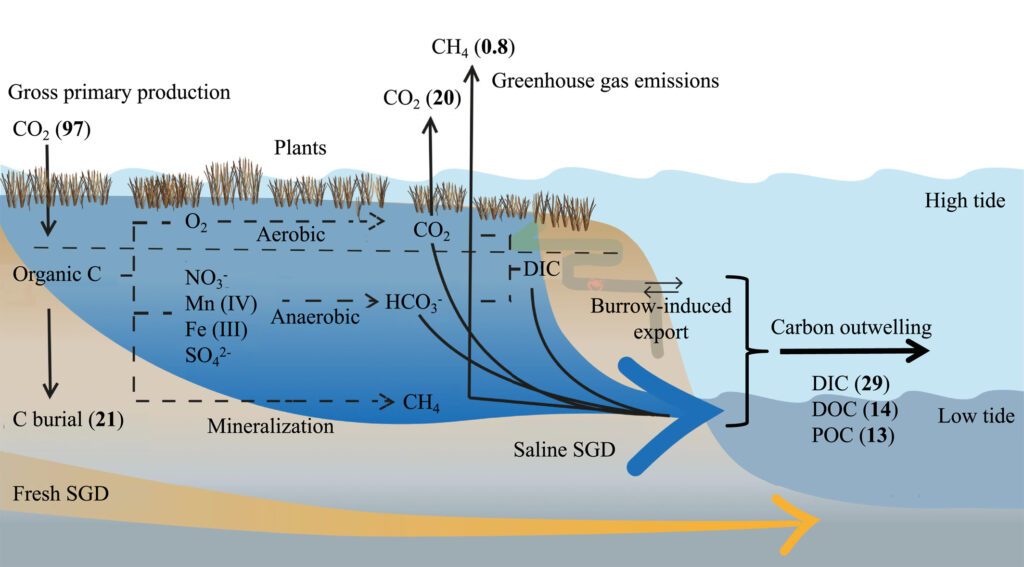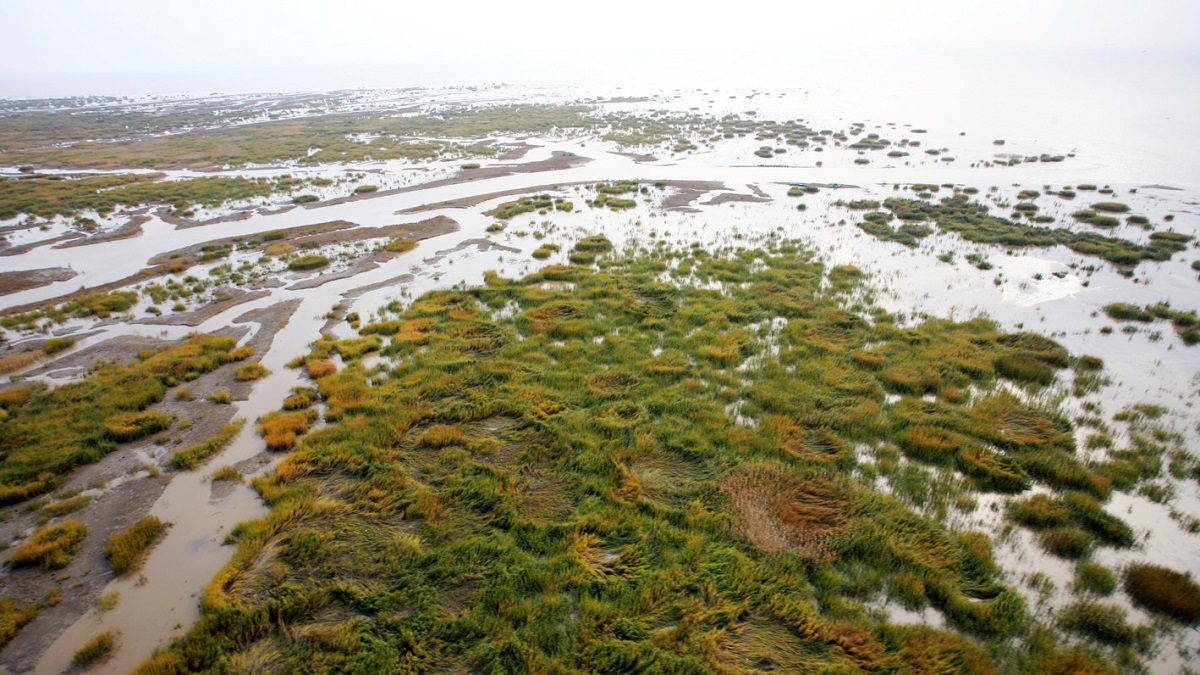Editors’ Vox is a blog from AGU’s Publications Department.
Salt marshes are highly productive wetlands that provide important ecological services and play a vital role in coastal carbon cycling. Unfortunately, around 50 percent of the world’s original salt marshes have been lost over the past century. Many remaining salt marshes worldwide suffer from serious degradation and loss of ecosystem function.
A recent article in Reviews of Geophysics describes surface water and groundwater interactions in salt marshes and their impact on plant ecology and coastal biogeochemistry. Here, the authors give an overview of the function and importance of salt marshes and highlight some of the unresolved questions where additional research is needed.
What are salt marshes, where are they commonly found, and what role do they play?
Salt marshes are coastal ecosystems colonized by salt-tolerant plants such as herbs, grasses, or low shrubs. Salt marshes are typically found in the upper part of the intertidal zone in low-energy coastal areas. The United States and Australia host more than half of global salt marshes, but the remainder are widely distributed around the world.
Salt marshes maintain biodiversity by providing essential habitats for many organisms
Salt marshes maintain biodiversity by providing essential habitats for many organisms, they protect shorelines against storms, and also act as natural pollution filters. Salt marshes are a so-called “blue carbon” ecosystem because they are carbon sinks, sequestering greenhouse gases and playing a role in offsetting climate change.
How do surface water and groundwater interact in salt marshes?
Surface water and groundwater interactions in salt marshes are primarily driven by tides. During rising tides, surface water overtops creek banks, flows over the marsh platform and infiltrates through the marsh sediment surface. When the marsh platform is gradually exposed during falling tides, groundwater seeps out from the marsh sediments into tidal creeks. This drainage lowers the water table and releases solutes from salt marsh soils. This tidally driven exchange can be influenced by other forcing factors such as waves, freshwater recharge (e.g., rainfall-induced infiltration), evapotranspiration, and sea level rise. The degree of exchange also depends on the composition of the marsh sediments and the shape of the marsh platform and adjacent tidal creeks. These multiple factors interact to control the hydrology and result in variations in soil conditions in marsh systems.

How does hydrology affect plant growth and zonation in salt marshes?
Plants in salt marshes commonly grow in distinct spatial patterns depend on biotic, hydrological, and geomorphological factors. This includes plant physiology, competition between plant species, and abiotic stresses, such as frequent submergence by the tide, saline soil, and poor drainage. These hydrologic stresses commonly vary with the elevation of the marsh surface, creating distinct ecohydrological zones within individual marshes.
Regional variations in tidal conditions and climate create differences in ecological productivity and zonation. For instance, the influence of flooding and salinity stress appears to increase in warm regions with high evapotranspiration rates. Thus, the variation of hydrological environment across geographical scales should be taken into account to generalize the salt marsh development and plant zonation.
How do salt marshes export carbon and nutrients to the adjacent open water?
Carbon-rich salt marsh soils are periodically flushed by tides. During tidal flushing, seawater penetrates salt marshes and captures some of the soil carbon and essential nutrients, such as nitrogen and phosphorus. Seawater then drains back to the ocean with some of the salt marsh carbon and nutrients during falling tides. This process transfers large amounts of carbon from salt marshes to the sea, where carbon can be stored over the long term or become food for microbes. Vegetation growth restocks the soil carbon, providing a constant source for seaward export for as long as the salt marsh is healthy.

How do scientists observe and measure surface water and groundwater interactions in salt marshes?
Observing and measuring surface water and groundwater interactions in salt marshes is challenging due to widely varying soil and hydrological conditions, but a range of field techniques have been developed. Rates of groundwater flow are often determined using seepage meters and observations of water levels in wells. Mass balance and tracer approaches are also used at larger scales.
Increasingly sophisticated numerical models have also been developed to visualize flow patterns and calculate groundwater exchange. These models are rapidly evolving to capture the complex three-dimensional nature of salt marshes and temporally variable hydrologic conditions.
What are some unresolved questions where additional research is needed?
At the local scale, significant questions persist regarding the effects of temperature variations, bioturbation, human activities, and climate change on groundwater flow and transport. The links among surface water and groundwater interaction, plant ecology, and coastal biogeochemistry are complex and difficult to quantify. Our methods must also expand to go beyond individual marshes to resolve much larger spatial areas and longer periods, to support regional restoration efforts and adaptation to climate change. Multidisciplinary collaboration among hydrologists, environmental scientists, ecologists, geomorphologists, oceanographers, and climatologists is urgently needed to advance our understanding of salt marshes and enhance our ability to protect and restore these valuable wetlands.
Multidisciplinary collaboration among hydrologists, environmental scientists, ecologists, geomorphologists, oceanographers, and climatologists is urgently needed to advance our understanding of salt marshes and enhance our ability to protect and restore these valuable wetlands.
—Pei Xin ([email protected], ![]() 0000-0002-3090-3409), Hohai University, China; Alicia Wilson (
0000-0002-3090-3409), Hohai University, China; Alicia Wilson (![]() 0000-0002-1113-6267), University of South Carolina, USA; Zhenming Ge (
0000-0002-1113-6267), University of South Carolina, USA; Zhenming Ge (![]() 0000-0001-7446-6135), East China Normal University, China; and Isaac Santos (
0000-0001-7446-6135), East China Normal University, China; and Isaac Santos (![]() 0000-0003-0524-842X), University of Gothenburg, Sweden
0000-0003-0524-842X), University of Gothenburg, Sweden
Editor’s Note: It is the policy of AGU Publications to invite the authors of articles published in Reviews of Geophysics to write a summary for Eos Editors’ Vox.

